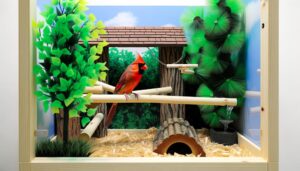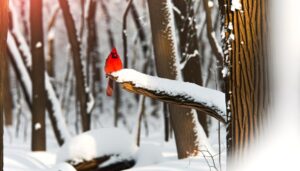How Does the Northern Cardinal Migrate?
The Northern Cardinal doesn't migrate and remains a year-round resident within its established territory. Unlike many avian species that undertake long-distance migrations, cardinals exhibit stationary behavior, supported by extensive observational data.
Their ability to adapt to varied habitats allows them to thrive without movement. This non-migratory tendency is advantageous as cardinals efficiently exploit available food resources and cope well with seasonal changes.
Their robust adaptability in colder climates negates the need for migration. Understanding these behaviors highlights the remarkable survival strategies of the Northern Cardinal.
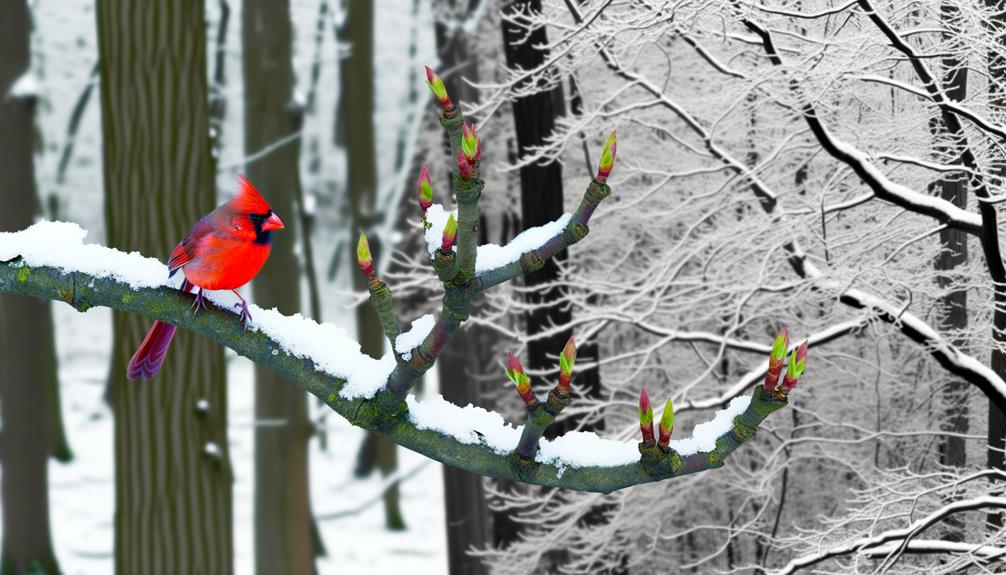
Key Takeaways
- Northern Cardinals are generally non-migratory and remain in the same area year-round.
- They adapt to seasonal changes by altering their diet and behavior rather than migrating.
- During winter, they form small flocks for warmth and survival.
- Cardinals may expand their range slightly in search of food but do not migrate over long distances.
- They use dense foliage and coniferous trees for shelter during colder months instead of migrating.
Northern Cardinal Overview
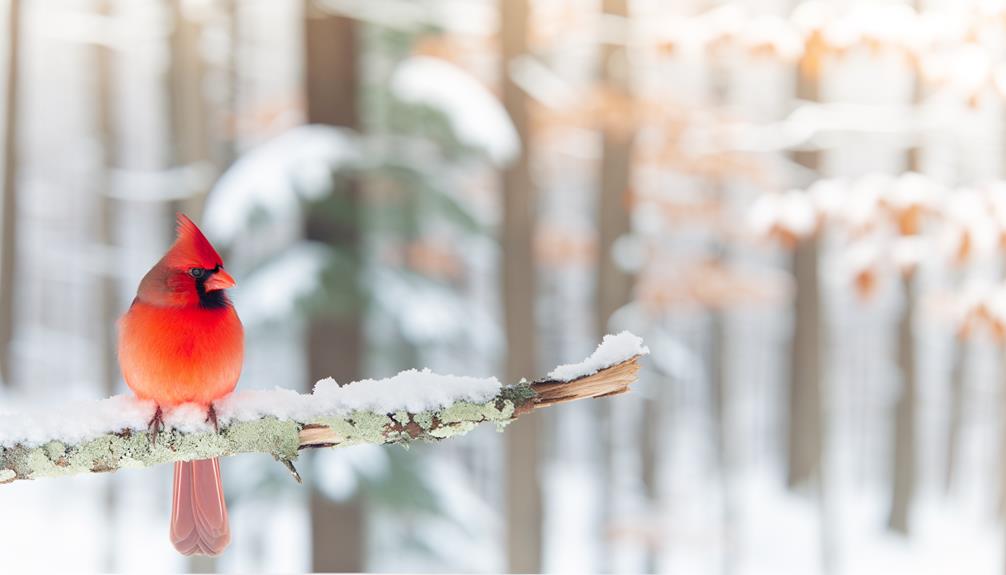
The Northern Cardinal (Cardinalis cardinalis) is a medium-sized songbird known for its vibrant red plumage and distinctive crest.
Males exhibit a striking red coloration, while females display more subdued tan or brown hues with red accents. Both sexes possess a robust, conical beak ideal for seed consumption. Their length ranges from 21 to 23 centimeters, with wingspans extending up to 31 centimeters.
Observational data reveal that Northern Cardinals thrive in various habitats, including woodlands, gardens, and wetlands. They're non-migratory residents, maintaining year-round territories.
Their diet primarily consists of seeds, supplemented by insects and fruits. Breeding pairs are monogamous, often raising multiple broods per season.
These behavioral and physiological traits underscore their adaptability and ecological significance.
Migration Patterns in Birds
While the Northern Cardinal remains a stationary resident year-round, many avian species exhibit distinct migration patterns shaped by seasonal changes and environmental pressures.
Birds like the Arctic Tern undertake extraordinary long-distance migrations, traveling from the Arctic to the Antarctic annually, covering approximately 25,000 miles. Such migrations are driven by the availability of food resources, breeding habitats, and climatic conditions.
Data show that about 40% of bird species migrate, utilizing celestial navigation, magnetic fields, and environmental cues. Furthermore, temperature changes prompt species like the American Robin to move southward during winter months.
These migratory behaviors are vital for survival and reproductive success, ensuring birds can exploit ideal conditions across different geographic regions throughout the year.
Cardinal's Habitat Preferences
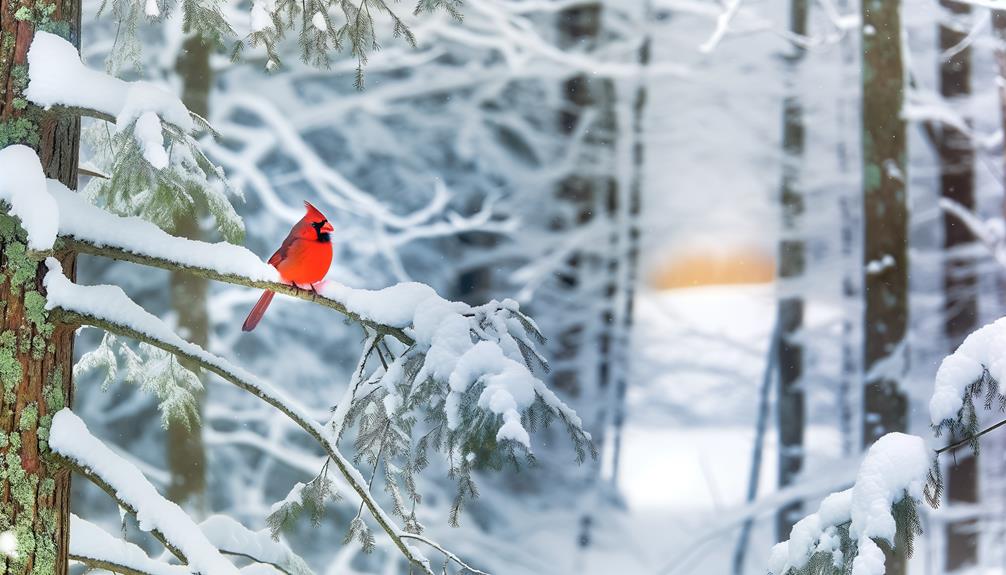
The Northern Cardinal primarily inhabits wooded areas, gardens, and shrublands. They demonstrate a preference for dense, bushy environments that provide ample cover and food resources.
Data indicates minimal seasonal habitat variation, suggesting a high level of adaptability to different environmental conditions throughout the year.
Observations confirm that cardinals remain in their chosen habitats year-round, negating the need for migratory behavior.
Preferred Environment Types
Northern Cardinals thrive in diverse habitats ranging from woodlands and gardens to wetlands and shrublands, showing a strong preference for dense, shrubby areas that provide ample cover and abundant food sources. These environments offer the necessary resources for nesting, foraging, and protection from predators.
Cardinals are commonly found in:
- Deciduous forests with thick underbrush, which offer both food and nesting sites.
- Urban parks and suburban gardens, where bird feeders and ornamental plants provide a steady food supply.
- Riparian zones along rivers and streams, where dense vegetation supports their feeding habits.
Observations indicate Cardinals favor environments rich in berry-producing shrubs, such as dogwood and honeysuckle, and areas with plenty of insects, meeting their dietary needs. Their adaptability to various habitats reflects their resilience and resourcefulness.
Seasonal Habitat Changes
Seasonal habitat changes influence the Northern Cardinal's preferences, often leading them to seek areas with ample food supplies and adequate shelter to cope with harsh weather conditions. During autumn and winter, cardinals favor dense shrubs and evergreen trees that offer protection from cold and predators. In contrast, spring and summer see a preference for areas rich in insects and seeds, such as forest edges and suburban gardens. Research indicates that habitat selection is critical for survival and reproductive success, with cardinals exhibiting notable adaptability.
| Season | Preferred Habitat |
|---|---|
| Spring | Forest edges, gardens |
| Summer | Insect-rich areas |
| Autumn | Dense shrubs |
| Winter | Evergreen trees |
These preferences highlight the cardinal's ability to optimize resource use year-round.
Seasonal Behavior of Cardinals
The Northern Cardinal exhibits distinct seasonal behaviors, with marked changes during the breeding season and winter. Studies show that cardinals establish and defend territories aggressively in spring, leading to increased vocalizations and nest-building activities.
In contrast, their winter adaptations include forming small flocks and altering their diet to include more seeds and berries, enabling survival in colder climates.
Breeding Season Patterns
During the breeding season, male Northern Cardinals exhibit heightened territorial aggression, often engaging in vocalizations and physical displays to defend their nesting area. This behavior includes:
- Song and Calls:
Males sing complex, melodious songs to mark their territory and attract mates.
- Physical Displays:
Aggressive behaviors like crest raising and wing flicking are common to deter intruders.
- Nesting:
Pairs build nests in dense shrubs or low trees, utilizing twigs, bark, and grasses.
Females lay 2-5 eggs per clutch, and both parents share incubation duties. Studies indicate that territories average 0.8 to 1.2 acres, ensuring ample resources.
Research shows breeding peaks from March to August, correlating with food availability. Understanding these patterns offers insights into their non-migratory behavior.
Winter Adaptations
Adaptability in Northern Cardinals is evident during winter months, as they exhibit behavioral and physiological changes to cope with colder temperatures and reduced food availability.
These birds increase their foraging activity, particularly at dawn and dusk, to maximize limited daylight hours. Data shows they frequent backyard feeders, consuming high-energy seeds like sunflower and safflower.
Physiologically, cardinals grow denser plumage, providing enhanced insulation against the cold. Their metabolic rate also adjusts, allowing efficient energy usage.
Social behavior shifts too; cardinals form loose flocks, enhancing vigilance against predators. Studies indicate that these adaptations collectively bolster their winter survival, negating the need for migration.
Such resilience underscores the species' remarkable ability to thrive in harsh winter conditions.
Food Sources in Winter

Northern Cardinals rely on various food sources such as seeds, fruits, and insects to sustain themselves throughout the harsh winter months. Their diet is essential for survival, given the scarcity of resources and lower temperatures. Data indicates that they primarily consume:
- Seeds: Sunflower seeds are a favorite due to their high-fat content.
- Fruits: Berries like dogwood and hackberry provide essential vitamins.
- Insects: While less abundant in winter, they still scavenge for any available larvae.
Detailed observations show that Northern Cardinals often frequent bird feeders, especially during snow-covered months. Studies reveal that consistent food supply impacts their winter survival rates positively. Understanding their winter diet is vital for conservation efforts and ensuring their continued presence in northern habitats.
Adaptations to Cold Weather
Several physiological and behavioral adaptations enable the Northern Cardinal to endure the frigid conditions of its winter habitat. Their plumage thickens in response to dropping temperatures, providing better insulation.
Cardinals also exhibit shivering thermogenesis, a process where muscle contractions generate heat. Behaviorally, they alter their feeding patterns, foraging more frequently to maintain their metabolic rate.
Cardinals often roost in dense foliage or coniferous trees, which offer shelter from wind and snow. Additionally, they form small flocks, utilizing collective body heat for warmth.
Data indicates that these adaptations collectively reduce winter mortality rates, allowing Northern Cardinals to thrive in colder climates without migrating. Their survival strategies highlight the intricate balance between physiology and environment in avian species.
Breeding and Nesting Habits

Breeding season for the Northern Cardinal typically begins in early spring, characterized by males singing to establish territories and attract mates. Females select nesting sites, often in dense shrubbery or low trees. They construct nests using twigs, leaves, and grasses, creating a sturdy structure to support their eggs.
Egg Laying: Females usually lay 3-4 eggs per clutch.
Incubation Period: Lasts approximately 11-13 days, primarily attended by the female.
Fledging: Chicks leave the nest about 9-11 days after hatching.
During this period, both parents participate in feeding the young, providing a diet rich in insects and seeds. Studies indicate that Northern Cardinals may raise multiple broods in a single breeding season, maximizing reproductive success.
Predators and Threats
Numerous predators pose substantial threats to the Northern Cardinal, including domestic cats, hawks, and snakes, each impacting their survival rates and nesting success. Domestic cats account for considerable predation, often targeting ground-level nests. Studies indicate that up to 20% of cardinal nest failures are attributed to feline predation.
Hawks, particularly Cooper's Hawks, prey on adult cardinals, notably reducing their population. Research shows that areas with high hawk populations exhibit up to 30% lower cardinal densities.
Snakes like the rat snake are notorious for raiding nests, consuming both eggs and nestlings. Observational data reveals that snake predation can lead to 15-20% nest failure rates. These predatory pressures collectively threaten the Northern Cardinal's stability in various habitats.
How to Support Cardinals

Understanding the threats Northern Cardinals face is crucial for developing effective strategies to support their populations and enhance their habitat conditions. Their primary challenges include habitat loss, predation, and food scarcity.
To address these issues, one can employ several strategies based on scientific observations and data:
- Provide Native Plants: These offer natural food sources and shelter, improving survival rates.
- Install Bird Feeders: Supplementing their diet with seeds, especially sunflower seeds, can be beneficial, particularly during winter.
- Create Safe Nesting Sites: Dense shrubs and thickets can safeguard nests from predators.
Implementing these measures not only supports Northern Cardinals but also contributes to broader biodiversity conservation efforts. This comprehensive approach guarantees a sustainable environment for avian populations.
Conclusion
To sum up, northern cardinals, unlike migratory birds, remain in their habitats year-round. Their non-migratory behavior is supported by their adaptability to cold weather and diverse winter food sources.
Cardinals' vibrant red plumage and distinctive songs add color and life to winter landscapes. To support these resilient birds, providing feeders with sunflower seeds and maintaining shrubs for shelter is essential.
So, even in the winter doldrums, cardinals are the steadfast companions of backyard birdwatchers.




